Do you constantly find yourself fumbling with the Enter key on your keyboard? Are you unsure which keyboard layout is right for you? In this post, I will discuss in detail about the comparison of ANSI vs ISO, the two most popular layouts you find for your keyboard.
Here are the Key Differences between ANSI and ISO in brief:
ANSI is used in the US and Netherlands, while ISO is more common in Europe. ISO keyboards have one extra key, with 105 keys on full-sized keyboards and 88 keys on compact-sized keyboards. ANSI keyboards have 104 and 87 keys, respectively. Also, ANSI keyboards have a smaller ENTER Key than ISO Ones.
So, this was in brief, however, to know the entire thing in detail, keep reading to learn more.
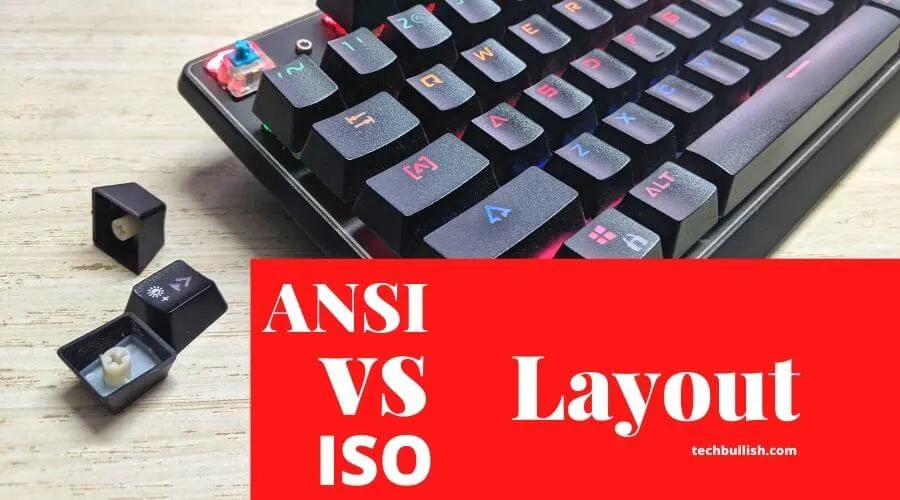
Why Should you Trust Me? Hi, I am Anirban Saha, an Engineer with a Specialization in Electronics and Communication Engineering. I have experience in Smart TVs, Electronics circuits, and Computer peripherals.
Want to Know More? Let’s get started!
ANSI vs ISO
| ANSI | ISO | |
| Full Form | American National Standards Institute | International Organization for Standardization |
| Enter Key | Rectangle-shaped Enter key | Inverted L-shaped Enter key |
| Backslash Key | The backslash key is above the Enter key. | The backslash key is to the left of the Enter key. |
| Left Shift Key | The left shift key is the same size as the Right shift key. | The left shift key is about 50% smaller than the right shift key |
| Alt Key | Left and Right Alt keys are the same | The right Alt key is replaced with an Alt Gr key (Alt Graph Key). |
| Number of Keys for Full Size | 104 keys | 105 keys |
| Number of Keys for Tenkeyless | 87 keys | 88 keys |
| Number of Keys for 60% layout | 68 keys | 69 keys |
| Advantages | Better Placement of keys for normal usage is better ergonomics | Better support for extended symbols and the European language. |
The below image shows the ANSI and the ISO Keyboard layout side by side.
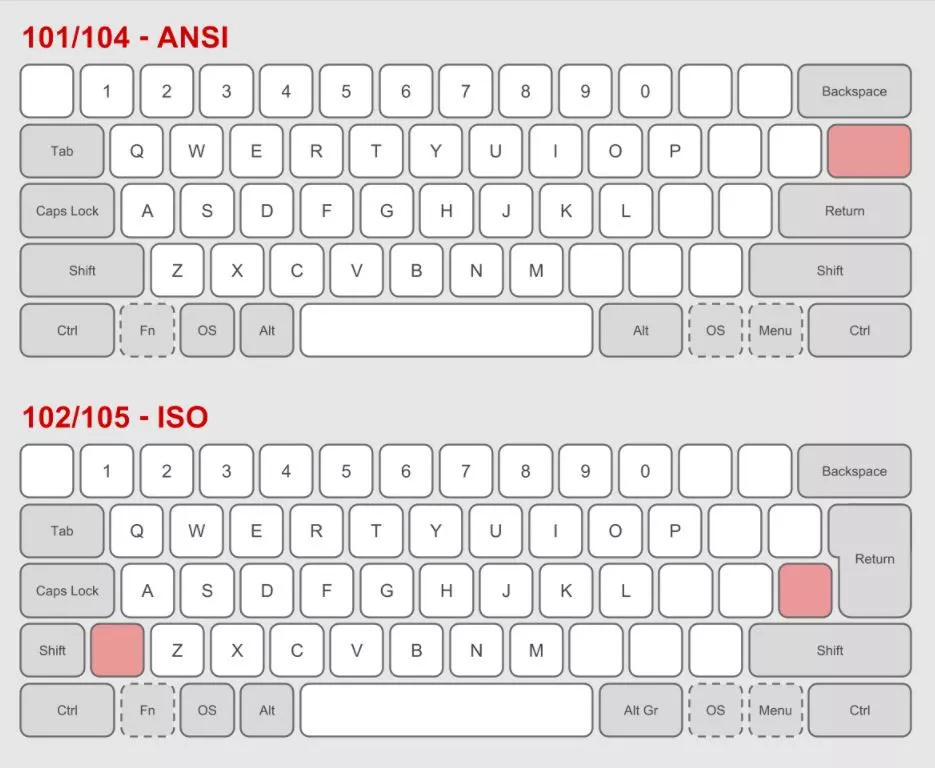
Here are the differences between ANSI and ISO keyboards as below:
#1. Enter Key Shape
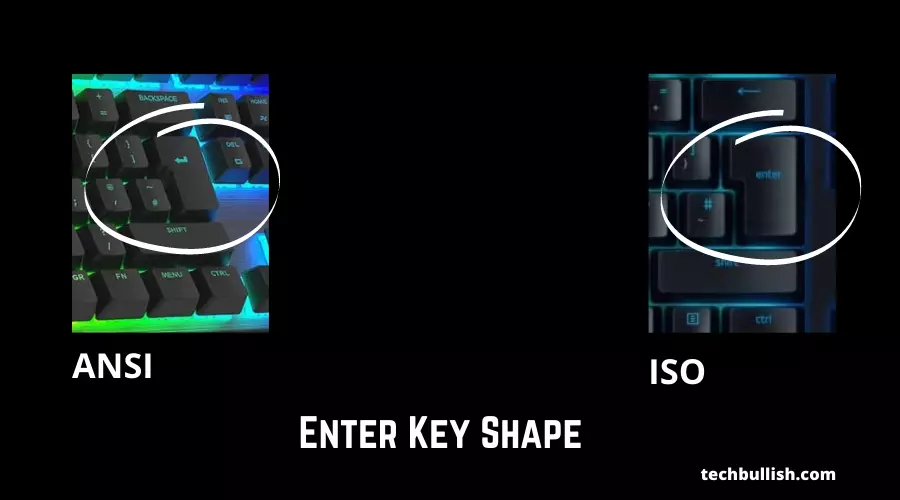
The most obvious is that the ANSI Keyboard has a smaller Enter key or Return Key, while the ISO layout has a larger one.
Additionally, the shape of the Enter key is also different for these layouts.
The ANSI keyboard layout has a smaller rectangular-shaped Enter key. On the other hand, the ISO Enter key looks Inverted L-shaped.
The ANSI Enter key is more easily usable and reachable using the pinky finger than the ISO enter key.
#2. Left Shift Key Size
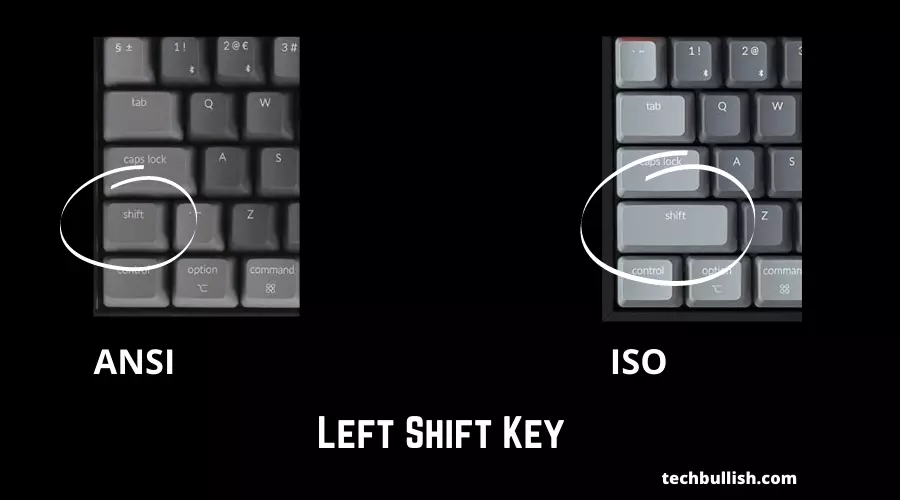
Another difference between these layouts is in the Left Shift Key size. In the case of the ANSI Keyboard, the Left and the Right Shift keys are of the same size.
However, in the case of the ISO layout, the Left Shift key is significantly smaller by 50% than the right Shift key.
Now the size comes close to the Ctrl key on the keyboard. If you shift from ANSI to ISO, you will accidentally click the key next to the shift key, the tilde key.
#3. Backslash Key Position
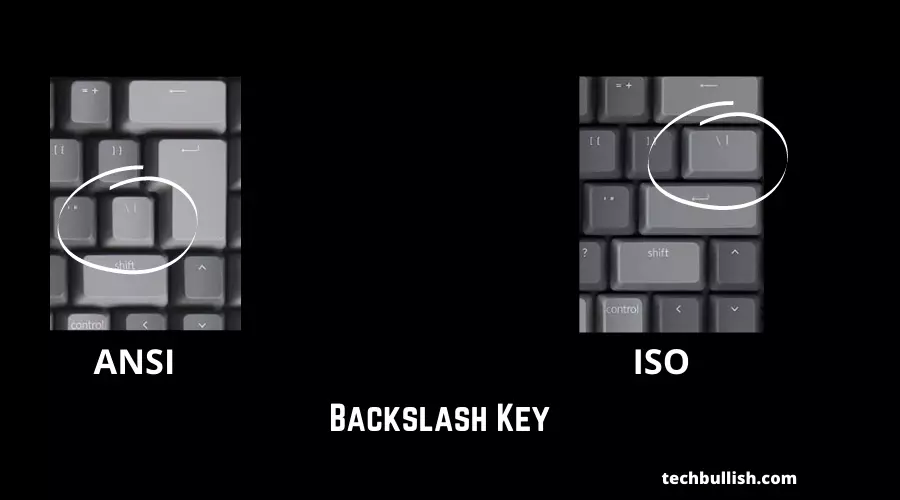
The ANSI layout has the Backslash Key(“\”) in the middle of the Enter Key and the Backspace Key, while the ISO layout has it in the lower left-hand corner of the Enter Key and below the Curly or Box Braces Key(“{ or ]”).
#4. Backtick Key or Tilde Key
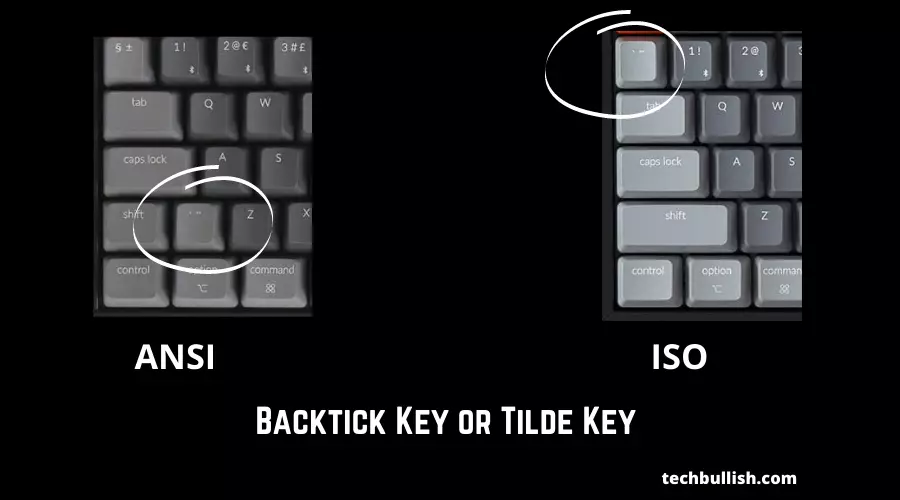
The Tilde or Backtick key (` or ~ symbol key) is present at different positions in the case of the ANSI and ISO layouts.
In ISO layout keyboards, this key is present on the top left of the keyboard and lies just on the Left of the Numeric 1 key.
However, in the case of the ISO layout keyboards, the Backtick key or the tilde key is present on the bottom left and is situated on the right of the left shift key.
It is the additional key present in the ISO layout beside the Shift key.
#5. Right Alt Key Changes to Alt GR
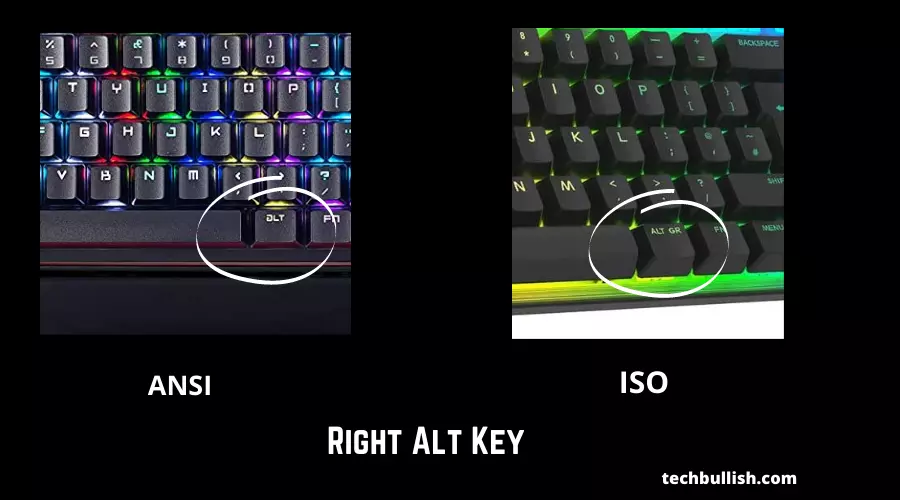
In the case of the ANSI Layout, there are Alt keys on both Left and right sides of the Spacebar of the same size.
However, in the case of ISO layout keyboards, the right Alt key is replaced by another key known as the Alt Gr Key (Alt Graph Key).
Alt Gr key is present in the ISO layout to support more characters, which is not normal English alphabets or numbers.
Alt Graph Key acts as a modifier key that gives input to foreign currency symbols, accent letters, and more characters like typographic marks from your mechanical keyboard.
E.g., To type Euro Symbol(€) using the keyboard, we can use Alt Gr+E.
#6. The total Number of Keys is Different
In the case of ISO layout, there is an additional key present compared to the total count of keys in ANSI layout keyboards.
Here is the comparison with respect to the Total number of keys of ANSI and ISO below:
| Full-Sized Keyboard | Compact Keyboard Tenkeyless | 60% Keyboard Layout | |
| Total Number of Keys in ANSI layout | 104 keys | 87 keys | 68 keys |
| Total Number of Keys in ISO layout | 105 keys | 88 keys | 69 keys |
What is ANSI Keyboard Layout?
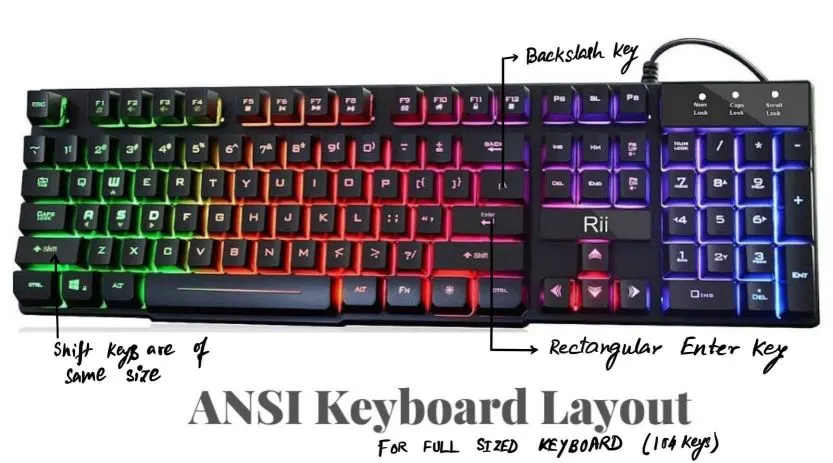
ANSI stands for American National Standards Institute. ANSI layout is a layout or keyboard key arrangement by American National Standards Institute. American National Standards Institute’s operations office is in New York.
This layout is used widely in the United States and the Netherlands. The uniqueness of this layout is mainly the full-size keyboards contain 104 keys, and the Enter key is rectangular.
The above image is a full-size ANSI keyboard layout with 104 keys.
Advantages
ANSI is the most common and widely used keyboard layout.
- The ANSI keyboard has great Ergonomics, and you will have a great typing experience.
- The key placement is just perfect for typing in English. The position of the keys feels easily reachable without much time and supports faster typing.
- Better availability of keycaps as the ANSI layout is common for keyboards.
- FULLY CUSTOMIZABLE & STUPIDLY FAST with OmniPoint...
- RAPID TRIGGER — Eradicate latency arising from...
- ULTIMATE CONTROL — 40 levels of per-key...
Last update on 2025-10-22 / Images from Amazon Product Advertising API
Disadvantages
Though I use the ANSI layout for my keyboard. Still, these are the disadvantages I found:
- The backslash key is far away from the entry key. This means it will be far away, considering the normal position you hold your keyboard.
- Enter key is rectangular block-shaped and is less noticeable during fast typing.
- The ANSI keyboard layout has less support for non-English languages requiring additional symbols. The ISO Keyboard is way better for other international languages.
What is ISO Keyboard Layout?
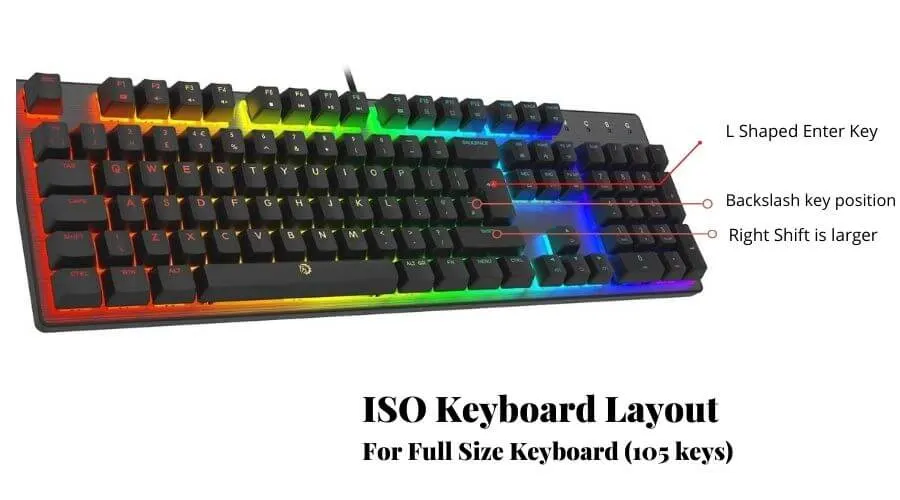
ISO stands for International Organisation for Standardisation. This ISO layout is a type of keyboard layout with a different key arrangement convention.
The ISO layout is used widely in European countries. This type of keyboard layout has exceptional support for the different symbols.
The above image is a full-size ISO keyboard layout with 105 keys.
Advantages
ISO layout for the keyboards is great for international users not using English. Let’s discuss the advantages of ISO keyboard layout.
- The ISO layout has more support for symbols than the ANSI layout. For e.g., you can type the Dollar symbol “$” with (Shift + 4) keys and the Pound symbol “€” with the (4+ Alt Gr) keys. (Alt Gr refers to the right Alt button).
- The ISO layout has the backslash key near the Enter key. So, if you use the backslash key a lot during typing, this ISO layout would be very helpful.
Disadvantages
ISO layout is a less common keyboard layout used for keyboards. The disadvantages are:
- It isn’t easy to find the keycaps separately for the ISO layout. So, we use ANSI keycaps in that place.
- The left and right shift keys are of different sizes. You might feel a bit weird if you are moving from an ANSI layout to an ISO layout.
- Though the Enter key and the backspace keys are closer in ISO, this increases the distance in reaching the Enter key. This is an important factor as, during typing, the Enter key is frequently used.
- These keyboards are comparatively more expensive than the ANSI layout keyboards. So, the extra cost is a disadvantage.
Which is Better: ANSI or ISO?
The ANSI and ISO are two World Standards Organizations that help to Consensus standards for Products and Services.
Though there are different advantages and disadvantages for these two layouts, there may be a variation in opinions regarding the layout and which one is perfect.
Different countries have made their standards in the keyboard layout which they follow.
The ANSI layout is widely used in the Netherlands and the United States. However, ISO keyboards are used in European countries.
The ISO keyboard layout has added advantages to support the European language better than the ANSI layout.
Neither layout is inherently better than the other, and both have their advantages and disadvantages.
The different types of keyboard layouts are advantageous to the language you use.
If you use a majorly English language, then the ANSI keyboards are better. However, if you use multiple languages and symbols often, the ISO keyboard layout has better support. Additionally, the ANSI keyboard layout has a smaller Enter key, while the ISO layout has a larger Enter key and an extra key to the left of the Z key. These differences can impact the comfort and efficiency of typing, especially for users who switch between languages frequently. Furthermore, the placement of specific keys on a computer keyboard, such as the location of the backslash and the vertical bar, varies between the ANSI and ISO layouts, which may also affect the user’s typing experience.
It is ultimately up to the individual user to decide which layout works best.
Frequently Asked Questions on ANSI vs ISO
Q. Is ANSI the same as ISO?
Q. Can I use ANSI keycaps on an ISO keyboard?
Q. What is the JIS layout?
They include five extra keys for Japanese characters not found on other keyboard layouts. The JIS layout can be used on computers running Windows, macOS, or Linux operating systems.
Q. Does the US use ANSI or ISO?
Q. Does the UK use ANSI or ISO?
Conclusion
Here I conclude my post on ANSI vs ISO!
ANSI and ISO keyboard layouts are commonly used in different regions of the world and have some notable differences in their design. The ANSI layout is used in the US and Netherlands, while the ISO keyboard is more common in Europe.
ISO keyboards have one extra key and some differences in key size and placement, such as a larger Enter key and a backslash key below the Enter key.
Both layouts have their own advantages and it ultimately comes down to personal preference and the type of work you do. It is worth considering trying out both layouts to see which one works best for you.

I’m Anirban Saha, Founder & Editor of TechBullish. With a B.Tech in Electronics and Communication Engineering, and 6+ years of experience as a software developer, I have expertise in electronics, software development, gadgets, and computer peripherals. I love sharing my knowledge through informational articles, how-to guides, and troubleshooting tips for Peripherals, Smart TVs, Streaming Solutions, and more here. Check Anirban’s Crunchbase Profile here.

